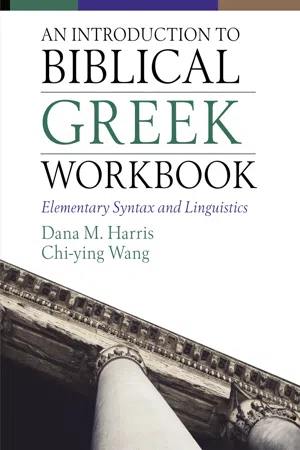
An Introduction to Biblical Greek Workbook
Elementary Syntax and Linguistics
- 208 pages
- English
- ePUB (mobile friendly)
- Available on iOS & Android
An Introduction to Biblical Greek Workbook
Elementary Syntax and Linguistics
About this book
This workbook is designed to accompany An Introduction to Biblical Greek Grammar, which focuses on the linguistic and syntactic elements of Koine Greek to equip learners for accurate interpretation. It reinforces key concepts student learn through parsing and translation exercises for each chapter. All texts are taken from the Greek New Testament and the Septuagint and include extensive syntactical and exegetical notes to aid students.
In An Introduction to Biblical Greek Grammar, author Dana Harris draws upon twenty years of Greek teaching experience and the latest developments in linguistics and syntax to introduce students to basic linguistic concepts and categories necessary for grasping Greek in ways that are clear and intuitive. This solid foundation enables students first to internalize key concepts, then to apply and build upon them as more complex ideas are introduced.
Several features are specifically designed to aid student's learning:
- Key concepts are graphically coded to offer visual reinforcement of explanations and to facilitate learning forms and identifying their functions
- Key concepts are followed by numerous examples from the Greek New Testament
- Students learn how to mark Greek texts so that they can begin to "see" the syntax, identify the boundaries of syntactic units, and construct syntactic outlines as part of their preaching or teaching preparation
- Four integrative chapters, roughly corresponding to the midterms and final exams of a two-semester sequence, summarize material to date and reinforce key concepts. Here students are also introduced to exegetical and interpretive concepts and practices that they will need for subsequent Greek studies and beyond.
- "Going Deeper" and "For the Curious" offer supplemental information for students interested in learning more or in moving to advanced language study.
Frequently asked questions
- Essential is ideal for learners and professionals who enjoy exploring a wide range of subjects. Access the Essential Library with 800,000+ trusted titles and best-sellers across business, personal growth, and the humanities. Includes unlimited reading time and Standard Read Aloud voice.
- Complete: Perfect for advanced learners and researchers needing full, unrestricted access. Unlock 1.4M+ books across hundreds of subjects, including academic and specialized titles. The Complete Plan also includes advanced features like Premium Read Aloud and Research Assistant.
Please note we cannot support devices running on iOS 13 and Android 7 or earlier. Learn more about using the app.
Information
chapter ONE
IMAGE-BEARERS, LANGUAGE,
LINGUISTICS, AND GREEK:
From Theological Reflections to Learning the Alphabet
CORRECTION AND ASSESSMENT
Instructions
| question | assessment | course of action |
| 1 | ||
| 2 | ||
| 3 | ||
| 4 | ||
| 5 | ||
| 6 | ||
| 7 |
ANSWER KEY
READING EXERCISE
1 Ἐν ἀρχῇ ἦν ὁ λόγος, καὶ ὁ λόγος ἦν πρὸς τὸν θεόν, καὶ θεὸς ἦν ὁ λόγος. 2 οὗτος ἦν ἐν ἀρχῇ πρὸς τὸν θεόν. 3 πάντα δι’ αὐτοῦ ἐγένετο, καὶ χωρὶς αὐτοῦ ἐγένετο οὐδὲ ἕν. ὃ γέγονεν 4 ἐν αὐτῷ ζωὴ ἦν, καὶ ἡ ζωὴ ἦν τὸ φῶς τῶν ἀνθρώπων· 5 καὶ τὸ φῶς ἐν τῇ σκοτίᾳ φαίνει, καὶ ἡ σκοτία αὐτὸ οὐ κατέλαβεν.6 Ἐγένετο ἄνθρωπος, ἀπεσταλμένος παρὰ θεοῦ, ὄνομα αὐτῷ Ἰωάννης· 7 οὗτος ἦλθεν εἰς μαρτυρίαν ἵνα μαρτυρήσῃ περὶ τοῦ φωτός, ἵνα πάντες πιστεύσωσιν δι’ αὐτοῦ. 8 οὐκ ἦν ἐκεῖνος τὸ φῶς, ἀλλ’ ἵνα μαρτυρήσῃ περὶ τοῦ φωτός.9 ῏Ην τὸ φῶς τὸ ἀληθινόν, ὃ φωτίζει πάντα ἄνθρωπον, ἐρχόμενον εἰς τὸν κόσμον. 10 ἐν τῷ κόσμῳ ἦν, καὶ ὁ κόσμος δι’ αὐτοῦ ἐγένετο, καὶ ...
Table of contents
- Cover Page
- Title Page
- Copyright Page
- Ebook Instructions
- Contents
- Acknowledgments
- A Note to Instructors
- Welcome to the Workbook!
- Abbreviations
- 1. Image-Bearers, Language, Linguistics, and Greek: From Theological Reflections to Learning the Alphabet
- 2. The Greek Verb from Cruising Altitude: Fasten Your Seatbelts, Please!
- 3. How to Build a Verb: The Present Active and Middle Indicative
- 4. The Greek Noun: A Case of Form and Function
- 5. The Article and the Adjective; the Verb εἰμί
- 6. Prepositions, Personal Pronouns, and Basic Conjunctions
- 7. The Imperfect Active and Middle Indicative; More On Prepositions
- 8. Text for Integration
- 9. Relatives, Demonstratives, and More Prepositions
- 10. Roots, Stems, and Principal Parts; the Aorist Active and Middle Indicative
- 11. Passives and Conditionals
- 12. Third Declension Paradigms: The Rest of Nouns and Adjectives; More Pronouns (Interrogative and Indefinite)
- 13. The Present Participle and Participle Basics
- 14. Text for Integration
- 15. The Aorist Participle and Additional Participle Functions
- 16. The Perfect and Pluperfect Indicative
- 17. The Perfect Participle and More Participle Functions
- 18. Contract Verbs
- 19. The Future Indicative and Participle
- 20. Text for Integration
- 21. The Subjunctive: Forms and Functions
- 22. The Imperative: Forms and Functions; More Pronouns
- 23. The Infinitive: Forms and Functions
- 24. μι Verbs: Finite Forms
- 25. μι Verbs: Nonfinite Forms
- 26. The Optative: Forms and Functions
- 27. Outlining New Testament Passages: Structural and Narrative Outlines
- 28. Text for Integration
- Scripture Index